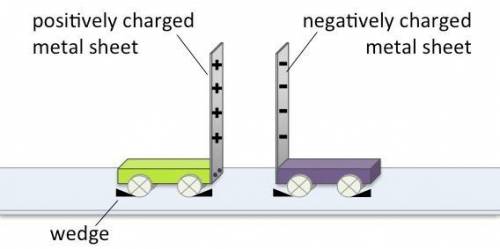
Physics, 15.12.2020 14:00 lasdivisionst6459
Predict how the force between the sheets would be different if this experiment were done with twice as much charge on each of the plates. Justify your prediction.


Answers: 3


Another question on Physics

Physics, 22.06.2019 05:00
The earth is constantly spinning on its axis, like you might spin a basketball on your finger. it is this spinning of the earth that causes
Answers: 3

Physics, 22.06.2019 12:30
Apositive charge moves in the direction of an electric field. which of the following statements are true? check all that apply. check all that apply. 1.the potential energy associated with the charge decreases. 2. the electric field does positive work on the charge. 3. the electric field does negative work on the charge. 4. the potential energy associated with the charge increases. 5. the electric field does not do any work on the charge. 6. the amount of work done on the charge cannot be determined without additional information.
Answers: 1

Physics, 22.06.2019 17:00
If a negatively charged particle is placed at rest in an electric potential field that increases in the positive x-direction, what will the particle do? a. accelerate in the positive x-direction b. remain at rest c. accelerate in the negative x-direction
Answers: 3

Physics, 22.06.2019 19:30
Amass m = 74 kg slides on a frictionless track that has a drop, followed by a loop-the-loop with radius r = 18.4 m and finally a flat straight section at the same height as the center of the loop (18.4 m off the ground). since the mass would not make it around the loop if released from the height of the top of the loop (do you know why? ) it must be released above the top of the loop-the-loop height. (assume the mass never leaves the smooth track at any point on its path.) 1. what is the minimum speed the block must have at the top of the loop to make it around the loop-the-loop without leaving the track? 2. what height above the ground must the mass begin to make it around the loop-the-loop? 3. if the mass has just enough speed to make it around the loop without leaving the track, what will its speed be at the bottom of the loop? 4. if the mass has just enough speed to make it around the loop without leaving the track, what is its speed at the final flat level (18.4 m off the ground)? 5. now a spring with spring constant k = 15600 n/m is used on the final flat surface to stop the mass. how far does the spring compress?
Answers: 3
You know the right answer?
Predict how the force between the sheets would be different if this experiment were done with twice...
Questions







Physics, 26.10.2019 00:43







History, 26.10.2019 00:43

Social Studies, 26.10.2019 00:43



Mathematics, 26.10.2019 00:43




